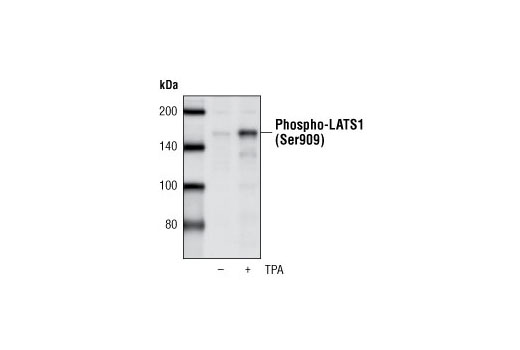WB
H
Endogenous
140
Rabbit
#O95835
9113
Product Information
Product Usage Information
| Application | Dilution |
|---|---|
| Western Blotting | 1:1000 |
Storage
Specificity / Sensitivity
Species Reactivity:
Human
Species predicted to react based on 100% sequence homology
The antigen sequence used to produce this antibody shares
100% sequence homology with the species listed here, but
reactivity has not been tested or confirmed to work by CST.
Use of this product with these species is not covered under
our
Product Performance Guarantee.
Mouse, Rat, Monkey
Source / Purification
Polyclonal antibodies are produced by immunizing animals with a synthetic phosphopeptide corresponding to amino acids surrounding Ser909 of human LATS1. Antibodies are purified by protein A and peptide affinity chromatography.
Background
The Large tumor suppressor (LATS) proteins (LATS1, LATS2) are serine/threonine kinases that belong to the NDR family (1). The Drosophila homolog (warts) was first identified as a tumor suppressor protein that plays a role in the maintenance of ploidy. Human LATS1 was shown to localize to the centrosome and the mitotic spindle and control G2/M transition by negatively regulating cdc2 kinase activity (2,3). LATS1 is also reported to play a role in the G1 tetraploidy checkpoint, via control of p53 expression (4). LATS1 affects cytokinesis by regulating actin polymerization through negative modulation of LIMK1 (5). LATS1 also binds the phosphorylated form of zyxin, a regulator of actin filament assembly. This interaction promotes localization of zyxin to the mitotic spindle, suggesting a role for actin regulatory proteins during mitosis (6). Decreased expression of LATS1 is associated with breast tumor aggressiveness (7), and mutations perturbing LATS1 have been associated with human sarcomas and ovarian sarcomas (8,9). LATS1 knockout mice develop soft-tissue sarcomas, ovarian stromal cell tumor, and display a high sensitivity to carcinogenic treatments (10). LATS1 and LATS2 have also been identified as key members of the Hippo signaling pathway, a conserved kinase cascade that functions to regulate cell growth and apoptosis (11). Phosphorylation of LATS by Mammalian Sterile-20-like proteins (e.g., MST1) results in LATS-mediated phosphorylation of the transcriptional co-activators YAP and TAZ (12, 13). LATS-mediated phosphorylation of YAP and TAZ promotes their cytoplasmic sequestration and association with 14-3-3 proteins, and subsequent proteasomal degradation, leading to downregulation of YAP/TAZ target genes that promote cell growth (11, 14).
- Tao, W. et al. (1999) Nat Genet 21, 177-81.
- Yang, X. et al. (2001) Oncogene 20, 6516-23.
- Xia, H. et al. (2002) Oncogene 21, 1233-41.
- Iida, S. et al. (2004) Oncogene 23, 5266-74.
- Yang, X. et al. (2004) Nat Cell Biol 6, 609-17.
- Hirota, T. et al. (2000) J Cell Biol 149, 1073-86.
- Morinaga, N. et al. (2000) Int J Oncol 17, 1125-9.
- Hansen, L.L. et al. (2002) Cancer Genet Cytogenet 139, 1-8.
- Hisaoka, M. et al. (2002) Lab Invest 82, 1427-35.
- St John, M.A. et al. (1999) Nat Genet 21, 182-6.
- Guo, C. et al. (2007) Curr Biol 17, 700-5.
- Hergovich, A. et al. (2006) Biochem Biophys Res Commun 345, 50-8.
- Hirabayashi, S. et al. (2008) Oncogene 27, 4281-92.
- Zhao, B. et al. (2010) J Cell Sci 123, 4001-6.
Species Reactivity
Species reactivity is determined by testing in at least one approved application (e.g., western blot).
Western Blot Buffer
IMPORTANT: For western blots, incubate membrane with diluted primary antibody in 5% w/v BSA, 1X TBS, 0.1% Tween® 20 at 4°C with gentle shaking, overnight.
Applications Key
WB: Western Blotting
Cross-Reactivity Key
H: human M: mouse R: rat Hm: hamster Mk: monkey Vir: virus Mi: mink C: chicken Dm: D. melanogaster X: Xenopus Z: zebrafish B: bovine Dg: dog Pg: pig Sc: S. cerevisiae Ce: C. elegans Hr: horse GP: Guinea Pig Rab: rabbit All: all species expected
Trademarks and Patents
使用に関する制限
法的な権限を与えられたCSTの担当者が署名した書面によって別途明示的に合意された場合を除き、 CST、その関連会社または代理店が提供する製品には以下の条件が適用されます。お客様が定める条件でここに定められた条件に含まれるものを超えるもの、 または、ここに定められた条件と異なるものは、法的な権限を与えられたCSTの担当者が別途書面にて受諾した場合を除き、拒絶され、 いかなる効力も効果も有しません。
研究専用 (For Research Use Only) またはこれに類似する表示がされた製品は、 いかなる目的についても FDA または外国もしくは国内のその他の規制機関により承認、認可または許可を受けていません。 お客様は製品を診断もしくは治療目的で使用してはならず、また、製品に表示された内容に違反する方法で使用してはなりません。 CST が販売または使用許諾する製品は、エンドユーザーであるお客様に対し、使途を研究および開発のみに限定して提供されるものです。 診断、予防もしくは治療目的で製品を使用することまたは製品を再販売 (単独であるか他の製品等の一部であるかを問いません) もしくはその他の商業的利用の目的で購入することについては、CST から別途許諾を得る必要があります。 お客様は以下の事項を遵守しなければなりません。(a) CST の製品 (単独であるか他の資材と一緒であるかを問いません) を販売、使用許諾、貸与、寄付もしくはその他の態様で第三者に譲渡したり使用させたりしてはなりません。また、商用の製品を製造するために CST の製品を使用してはなりません。(b) 複製、改変、リバースエンジニアリング、逆コンパイル、 分解または他の方法により製品の構造または技術を解明しようとしてはなりません。また、 CST の製品またはサービスと競合する製品またはサービスを開発する目的で CST の製品を使用してはなりません。(c) CST の製品の商標、商号、ロゴ、特許または著作権に関する通知または表示を除去したり改変したりしてはなりません。(d) CST の製品をCST 製品販売条件(CST’s Product Terms of Sale) および該当する書面のみに従って使用しなければなりません。(e) CST の製品に関連してお客様が使用する第三者の製品またはサービスに関する使用許諾条件、 サービス提供条件またはこれに類する合意事項を遵守しなければなりません。
